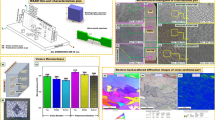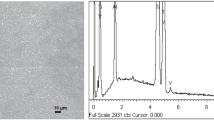Abstract
SiC particle–reinforced Al metal matrix composites (SiCp/Al) are typical difficult-to-machine materials due to the heterogeneous constituent. In order to explore the material removal mechanism in fixed abrasive polishing (FAP), polishing experiments were performed on SiCp/Al at 15 rpm and 35 rpm respectively, and surface integrity, including surface damage and material removal forms, was evaluated to explore the effects of different polishing speeds on it. The results indicate that high-speed polishing at 35 rpm may result in better surface quality. The polished SiC surface changes from a concave cavity to a fish scale shape, and the removal form of SiC particles changes from whole extraction and brittle fracture to ductile removal. A removal model for SiCp/Al in consolidated abrasive polishing was established, and the material removal mechanism was revealed. Simulate the removal of SiC particles at different depths using molecular dynamics simulation. We find dislocations will generate not only at the polishing region but also at the SiC–Al interface. Moreover, the motion of dislocations is obstructed by the nanoparticles, resulting in accumulation of dislocations between the tool and particles. Furthermore, it was found that the removed silicon carbide particles exhibited three-body wear during low-speed polishing, while they turned into two-body wear during high-speed polishing. Material removal rate (MRR) data showed that the standard deviation was reduced by 80% when switching from low-speed to high-speed polishing. This significant decrease underscores that high-speed polishing helps to improve SiCp/Al surface quality. Our researches benefit to understand the mechanical removal mechanism of SiCp/Al substrates and give theoretical guide for improving the machining technology of FAP.











Similar content being viewed by others
References
Zhang M, Zhou L, Song C, Zhu W (2021) Finite element analysis of the influence of microstructure on the mechanical properties of sicp/al composites. J Inst Eng (India): Series C 103(3):359–367
Zhang P, Yue X, Zhang Q, Zong C, Lu W, Fang Y (2021) Investigation on the influence of SiC particle parameters on the machinability of SiCp/Al composite. Vacuum 191:110340
Chen Y, Zhang X (2021) Study on the cutting mechanism of SiCp/Al considering particle size and distribution. Int J Adv Manuf Technol 115(4):1211–1225
Fan Y, Xu Y, Hao Z, Lin J (2022) Dynamic behavior description and three-dimensional cutting simulation of SiCp/Al composites with high volume fraction. J Manuf Process 77:174–189
Wang B, Qu S, Li X, Yuan W (2018) Optics Ag-mirror with high volume fraction-SiCp/Al composite–titanium alloy–PbO system glass metal plus dielectric multi-layer films. Opt Commun 423:121–126
Cao Y, Zhu Y, Li HN, Wang C, Su H, Yin Z, Ding W (2020) Development and performance of a novel ultrasonic vibration plate sonotrode for grinding. J Manuf Process 57:174–186
Cao Y, Yin J, Ding W, Xu J (2021) Alumina abrasive wheel wear in ultrasonic vibration-assisted creep-feed grinding of Inconel 718 nickel-based superalloy. J Mater Process Technol 297:117241
Miao Q, Ding W, Xu J, Cao L, Wang H, Yin Z, Kuang W (2021) Creep feed grinding induced gradient microstructures in the superficial layer of turbine blade root of single crystal nickel-based superalloy. Int J Extr Manuf 3(4):045102
Cao Y, Ding W, Zhao B, Wen X, Li S, Wang J (2022) Effect of intermittent cutting behavior on the ultrasonic vibration-assisted grinding performance of Inconel718 nickel-based superalloy. Precis Eng 78:248–260
Biao Z, Wenfeng D, Zhongde S, Jun W, Changfeng Y, Zhengcai Z, ... Xin W (2023) Collaborative manufacturing technologies of structure shape and surface integrity for complex thin-walled components of aero-engine: status, challenge and tendency. Chin J Aeronautics 36(7):1–24
Zhao B, Peng J, Ding W (2023) Machined surface formation and integrity control technology of SiCp/Al composites: a review. Surf Sci Technol 1(1):10
Li G, Xiao C, Zhang S, Sun R, Wu Y (2022) An experimental investigation of silicon wafer thinning by sequentially using constant-pressure diamond grinding and fixed-abrasive chemical mechanical polishing. J Mater Process Technol 301:117453
Tang H, Yang W, Liu W, Ma J, Luo X (2020) Characteristic of fixed abrasive polishing for fused silica in anhydrous environment. Optik 202:163623
Chen J, Zhu Y, Peng Y, Guo J, Ding C (2020) Silica-assisted fixed agglomerated diamond abrasive polishing. J Manuf Process 59:595–603
Li G, Xiao C, Zhang S, Luo S, Chen Y, Wu Y (2023) Study of the humidity-controlled CeO2 fixed-abrasive chemical mechanical polishing of a single crystal silicon wafer. Tribol Int 178:108087
Luo Q, Lu J, Xu X (2016) Study on the processing characteristics of SiC and sapphire substrates polished by semi-fixed and fixed abrasive tools. Tribol Int 104:191–203
Li Y, Xi M, Jiang B, Zhang Y, Zhang Z (2023) Structure-performance relationships of complexing agents on the chemical mechanical polishing of 6063 aluminum alloy. ECS J Solid State Sci Technol 12(4):044001
Du Y, Lu M, Lin J, Yang Y (2023) Experimental and simulation study of ultrasonic elliptical vibration cutting SiCp/Al composites: chip formation and surface integrity study. J Market Res 22:1595–1609
Zhou J, Lu M, Lin J, Zhou X, Guo M, Du Y (2022) Investigation of surface integrity transition of SiCp/Al composites based on specific cutting energy during ultrasonic elliptical vibration assisted cutting. J Manuf Process 79:654–665
Fang F, Lai M, Wang J, Luo X, Yan J, Yan Y (2022) Nanometric cutting: mechanisms, practices and future perspectives. Int J Mach Tools Manuf 178:103905
Srinath MK, Puneeth HV, Nagendra J, Prasad MG (2022) Fabrication and strength evaluation of nano-SiC particulate reinforced Al-6082 MMC’s. Mater Today: Proceedings 59:66–71
Huo S, Xie L, Xiang J, Pang S, Hu F, Umer U (2018) Atomic-level study on mechanical properties and strengthening mechanisms of Al/SiC nano-composites. Appl Phys A 124:1–12
Junfeng X, Lijing X, Xin H, Shiyan H, Siqin P, Xibin W (2019) Simulation and experimental research on ultra-precision turning of SiCp/Al composites. Rare Metal Mater Eng 48(5):1687–1696
Xu F, Fang F, Zhang X (2017) Hard particle effect on surface generation in nano-cutting. Appl Surf Sci 425:1020–1027
Zheng W, Wang Y, Zhou M, Wang Q, Ling L (2018) Material deformation and removal mechanism of SiCp/Al composites in ultrasonic vibration assisted scratch test. Ceram Int 44(13):15133–15144
Li J, Fang Q, Liu B, Liu Y (2016) The effects of pore and second-phase particle on the mechanical properties of machining copper matrix from molecular dynamic simulation. Appl Surf Sci 384:419–431
Liu Y, Wang Q, Lu C, Xue T, Hu B, Zhang C (2022) Microscopic residual stress evolution at the SiC/Al interface during nanoindentation via molecular dynamics simulation. Surf Interfaces 33:102210
Zhou J, Lu M, Lin J, Wei W (2023) Influence of tool vibration and cutting speeds on removal mechanism of SiCp/Al composites during ultrasonic elliptical vibration-assisted turning. J Manuf Process 99:445–455
Guo S, Cheung CF, Ho LT, Zhang B (2023) Microstructural evolution in ultra-precision grinding of Al/SiCp metal matrix composites. Precis Eng 83:12–21
Yuan Z, Xiang D, Peng P, Zhang Z, Li B, Ma M, Zhao B (2023) A comprehensive review of advances in ultrasonic vibration machining on SiCp/Al composites. J Mater Res Technol 24:6665–6698
Mendelev MI, Kramer MJ, Becker CA, Asta M (2008) Analysis of semi-empirical interatomic potentials appropriate for simulation of crystalline and liquid Al and Cu. Phil Mag 88(12):1723–1750
Tersoff JJPRB (1989) Modeling solid-state chemistry: interatomic potentials for multicomponent systems. Phys Rev B 39(8):5566
Zhao H, Chen N (2008) An inverse adhesion problem for extracting interfacial pair potentials for the Al (0 0 1)/3C–SiC (0 0 1) interface. Inverse Prob 24(3):035019
Acknowledgements
The authors would like to thank the Science and Technology Planning Project of Shanghai Science and Technology Commission for providing financial support for the paper (20030501100). In particular, the authors would like to thank the editor and reviewers for their constructive suggestions.
Author information
Authors and Affiliations
Contributions
All authors contributed to the study conception and design. Material preparation, data collection, and analysis were performed by Shujing Wu, Dazhong Wang, Kun Lu, Changhe Li, and Mao Cong. The first draft of the manuscript was written by Cheng Zhang and all authors commented on previous versions of the manuscript. All authors read and approved the final manuscript.
Corresponding author
Ethics declarations
Conflict of interest
The authors declare no competing interests.
Additional information
Publisher's note
Springer Nature remains neutral with regard to jurisdictional claims in published maps and institutional affiliations.
Rights and permissions
Springer Nature or its licensor (e.g. a society or other partner) holds exclusive rights to this article under a publishing agreement with the author(s) or other rightsholder(s); author self-archiving of the accepted manuscript version of this article is solely governed by the terms of such publishing agreement and applicable law.
About this article
Cite this article
Zhang, C., Wu, S., Wang, D. et al. Wear mechanism in nano polishing of SiCp/Al composite materials using molecular dynamics. Int J Adv Manuf Technol 131, 3057–3069 (2024). https://doi.org/10.1007/s00170-024-12955-8
Received:
Accepted:
Published:
Issue Date:
DOI: https://doi.org/10.1007/s00170-024-12955-8




